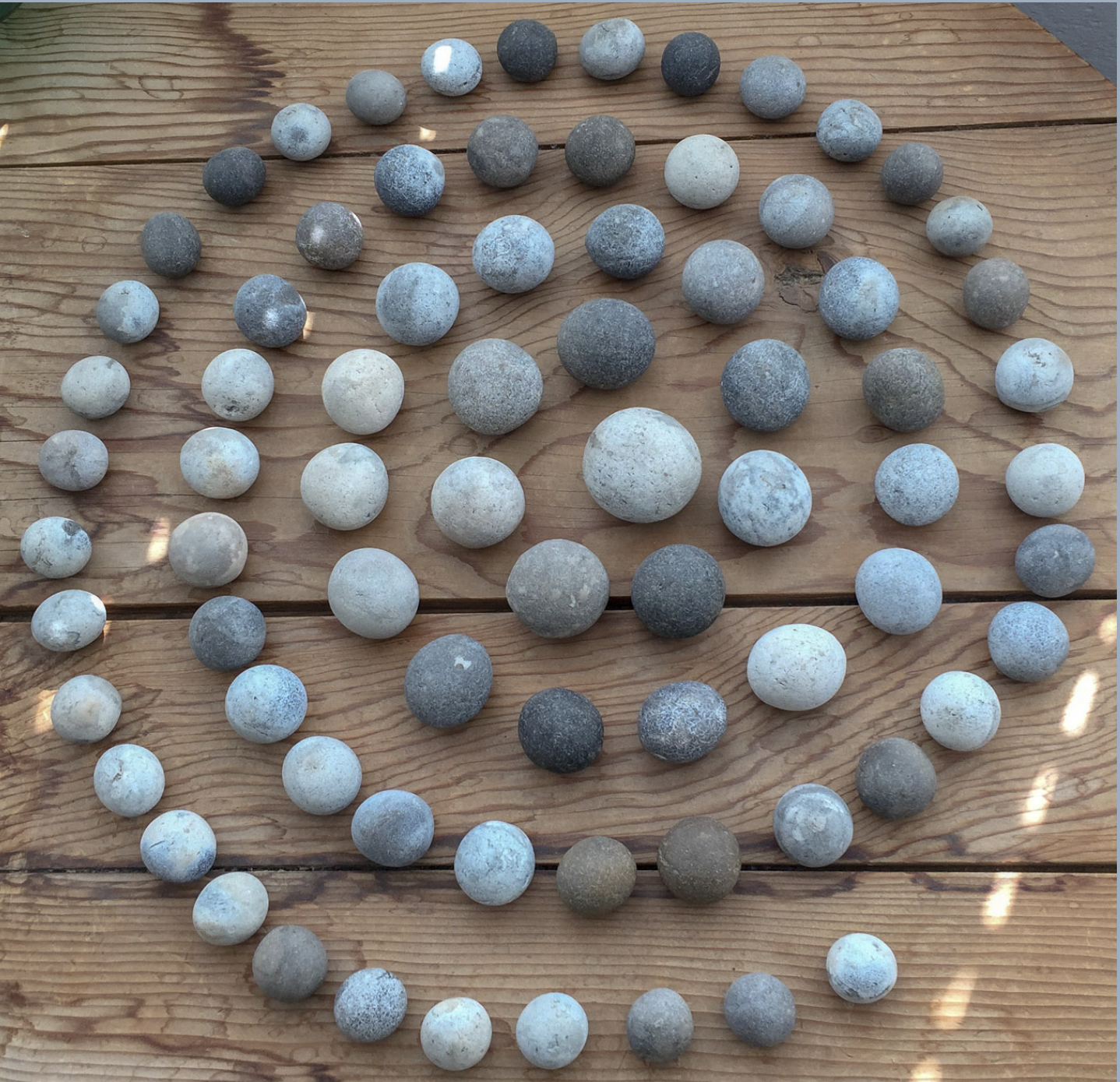
“Spiral of Stones” Jim Ede 1958, Kettle’s Yard, Cambridge.
In about 1958 Jim Ede arranged 76 limestone pebbles in a spiral on a table in Kettle’s Yard. Kettle’s Yard is the name given to a series of interconnected cottages in which Jim Ede housed his art collection. Yet Kettle’s Yard is so much more than an art gallery. It embodies a whole way of living this life. In each room, as well as works of art, he placed found objects, each one considered and carefully positioned. Throughout, he sought to create a personal sense of balance between the architecture, the objects in the space and their interaction with each other and with the light. In the image below of the table, you can see how the stones in spiral formation match the spherical shape of the glass float. At Kettle’s Yard, as you go from room to room you find this kind of silent resonance between objects everywhere, and then something of Jim Ede himself, because each object is positioned exactly as he left them. It embodies his “sense of balance”; his personal aesthetic. You can find out much more at https://www.kettlesyard.cam.ac.uk/explore-the-house-and-collection/a-handful-of-objects/spiral-of-stones/ At Kettle’s Yard, he is everywhere. He liked stones and pebbles. He picked these stones at Cley on the Norfolk coast. In September 1958 he wrote in a letter, “In our quiet life there is little to report, save that we are now in a little cottage half a mile from the Norfolk sea – a shore full of and overfull of pebbles – I can’t resist bringing back a load each day – we are to be here 2 weeks and expect it will do us both oceans of good.” And years later: “These are pebbles I picked up on a Norfolk beach. You have no idea how hard it is to find a really spherical pebble, round as a bullet ball, one of which we have at Kettle’s Yard. I made this spiral in 1958, really as a way to see the stones without taking up too much space. Perhaps an exemplar of necessity as the mother of invention. Now in 1973, I hear that a sculptor has hit the news with an exhibition of cement spheres on a large scale, arranged in this fashion.” Jim wrote a guide to Kettle’s Yard. He called it “Way of Life”. In it he wrote that he never intended to create the spiral of stones, stating that the shape arrived by chance. He writes; “as I placed them it occurred to me to grade them in size, and in doing so I started with the biggest […] surrounding it with smaller and smaller ones, and thus the spiral came into being.” But each individual stone was carefully chosen. Each was shaped by the ocean, made almost spherical by water. Each carries within itself the energy of millennia. Maybe Jim Ede could see in each pebble some level of kinship with ourselves, as the individuals we have become, and the network of relationships within which we live and by which we have been shaped. And yet just like a pebble on a beach, at the core of each of us is this person created in the image and likeness of God and utterly unique. Today’s Gospel has a focus on identity. In it, Jesus said to Simon, “you are Peter, and on this rock I will build my church”. As you all know, in the Greek text there is a pun between the words for Peter and rock: Petros/petra, (Mt 16:18). The Jordan River rises in the region Caesarea Philippi. It wells up from the rock. Downstream, Jesus had been baptised, that is to say immersed in its waters. Our chapel has something of the spirit of Kettle’s Yard about it, in the considered choice of objects and materials; in their arrangement; in the sensitivity to the play of light. It is a balancing of various relationships: aesthetic, religious and cultural. Some writers have termed it “alchemy”, perhaps because they did not have the language of faith. Here a rich tradition of faith surfaces in contemporary dress. Maybe before the winter comes, a little party of us could head to the ocean and pick some pebbles. I can see them on the middle window sill already!
The Catholic Chaplaincy serves the students and staff of the University of Edinburgh, Edinburgh Napier University and Queen Margaret University.
The Catholic Chaplaincy is also a parish of the Archdiocese of St Andrews and Edinburgh (the Parish of St Albert the Great) and all Catholic students and staff are automatically members of this parish.